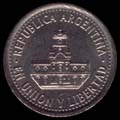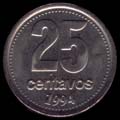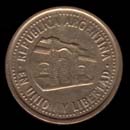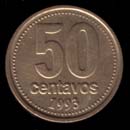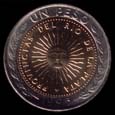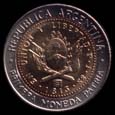Argentine coins
Argentine coins
The Argentine peso (ISO 4217 code: ARS, symbol: $) is the official currency in Argentina since 1992, when it replaced the austral. It was also called convertible peso because of its initial parity with the dollar until the amendment of the law of convertibility in 2002.
Peso before 1826
The only coins in circulation in Argentina at the time of colonization were the colonial Spanish real. Peso was the name used by the Spanish for the silver coin of eight reales. After the independence from Spain in 1816, Argentina began to mint its own coins, denominated real, sol and shields, including eight real silver (or sol) named peso.
Peso fuerte (1826–1881)
In 1826 there were issued two series of currencies in pesos. One of them, the peso fuerte ( ISO 4217 code: ARF, symbol $F) was a convertible currency, with an initial exchange ratio of 17 peso fuerte to one Spanish ounce (27.0643 g) of gold fineness of 0.916. The ratio was changed in 1864 to 16 peso fuerte to 1 ounce of gold.
Peso moneda corriente (1826–1881)
The second currency introduced in 1826 was the peso moneda corriente (symbol $m/n). It started at par with the peso fuerte, but became not convertible with time.
In 1822 the real Argentine was divided into 10 0 decimos, while in 1854, coins were introduced in Argentine cents (centavos). The denominations of the coins in decimos minted in copper, were 1, 5, 10 and 20 decimos, in addition to those from a quarter of a real, half real and 1 and 2 real. As far as the centavos, 1, 2 and 4 centavos coins were introduced.
The adoption of decimos and centavos coins, however, didn’t introduced a decimal monetary system in Argentina, which happened only in 1881 with the abandonment of the real and the adoption of the peso, with the ratio of 8 reales for 1 peso.
Gold and silver pesos (1881–1970)
The system in use before 1881 was described as "monetary anarchy" (anarquía monetaria). In 1881 was defined as monetary unit the peso oro sellado ("stamped gold peso"), with a reference gold coin of 1,612 grams of fineness of 90% (900), and a silver peso of 25 g of fineness 900 (ISO 4217 code: ARG). Were also used gold coins from 2.5 to 5 pesos, silver coins from 5, 10, 20 and 50 centavos to one peso, and coins of 1 and 2 centavos in copper.
Peso moneda nacional (1881–1970)
The Argentine peso (symbol = $m/n or m$n, ISO 4217 code = ARM) is the currency of Argentina from November 5, 1881 with the introduction of the decimal system with its subdivision into 100 cents, and remained in circulation until January 1, 1970.
The peso o moneda nacional replaced the previous currency at the exchange rate of 1 peso moneda nacional = 8 reales = 1 peso fuerte = 25 pesos moneda corriente. Initially there was a gold coin worth one Argentine peso, silver coins from 1 peso 50, 20 and 10 centavos, and in 1882, bronze coins from 2 to 1 centavos. The silver coin of one peso moneda nacional was known as patacon. However, the economic crisis in 1890 led to the cessation of emissions of silver coins.
At the beginning the peso moneda nacional was convertible at par with a peso oro sellado. The convertibility was initially adopted also to the French franc, with a exchange rate of 1 peso for five francs. In 1883, with the crisis of the Latin Monetary Union, the peso dropped to a value of 2.2 francs, equivalent to 638.7 mg of gold. With the crisis of the gold standard in 1914, the peso was linked to the US dollar in 1927, with a ratio of 2.36 peso for 1 dollar, changed in 1931 to 1.71 peso for 1 dollar and then 3 pesos to 1 dollar in 1933. From 1934 to 1939, the value of the Argentine peso was linked to the British pound, with a ratio of 15 pesos to 1 pound.
On 28 May 1935, the Central Bank of Argentina was founded (Banco Central de la República Argentina).
Peso ley (1970–1983)
The peso ley 18.188 (informally called peso ley) was in circulation in Argentina from 1 January 1970 to 5 May 1983 (symbol = $, ISO code 4217 = ARL). It replaced the peso moneda nacional to exchange rate of a peso ley to 100 pesos moneda nacional.
Initially, there were Argentine coins of 1, 5, 10, 20 and 50 cents. In 1974, due to the inflation, there were introduced 1 peso coins, in 1976 of 5 and 10 peso coins, while in 1978 were minted coins of 50 and 100 pesos.
Peso argentino (1983–1985)
It was the Argentine currency in circulation since June 6, 1983 to June 14, 1985 (symbol = $a, ISO 4217 code = ARP). It replaced the weight ley with a change of a peso each weight 10 000 ley.
The coins were initially planned for 1, 5, 10 and 50 centavos. In 1984 were minted coins of 1, 5 and 10 pesos, while in 1985 were also introduced coins of 50 pesos;
Austral (1985–1991)
The austral was the currency in circulation from 15 June 1985 to 31 December 1991 (symbol = ₳, ISO 4217 code = ARA). It replaced the Argentine peso to the exchange rate of 1 austral to 1000 pesos.
In 1985, coins were introduced for ½, 1, 5, 10 and 50 centavos. The pieces ½ centavo were issued only in 1985, while the production of 1 centavo ceased in 1987, 5 centavos ceased in 1988 and the other centavos coins ended in 1989. In 1989, coins were issued for 1, 5 and 10 austral, followed in 1990 and 1991 by the denominations of 100, 500 and 1000 austral.
Nuevo peso (1992)
In circulation since 1 January 1992 (symbol = $, ISO code 4217 = ARS) introduced an exchange rate of 1 nuevo peso to 10 000 austral.
The nuevo peso was initially called convertible peso, with its fixed ratio to 1 US dollar; this ratio was abandoned in February 2002 due to the economic crisis of 2001.
Coins
The coins currently in circulation have values of 1, 5, 10, 25, 50 centavos, 1 and 2 pesos.
1 centavo coins were minted in aluminum bronzes from 1992 to 1997 and from that year until 2001 they were issued in bronze (97% copper 3% tin).
The 5 centavos coins were made in aluminum bronzes from 1992 to 1993 and from 2004 to 2005; also issued coins of the same value in cupro-nickel from 1993 to 1995. Since 2006, all the 5 cent coins are made of brass coated steel.The 10 centavos coins were minted in bronze aluminum from 1992 to 2006. From 2006 to 2011 coins of this value were produced in steel coated brass.
The 25 centavos issued in 1992 and 1993 were in aluminum bronze, then were struck in cupro-nickel from 1993 to 1996. Since 2009 coins of this value were produced in aluminum bronze again.The value of 50 cents has always been coined in bronze aluminum for all its issues.
The bimetallic 1 peso coins were minted since 1994. The composition of the outer ring is in cupro-nickel, while the center is of aluminum bronze.
From 2012 a coins of two pesos replaced the equivalent banknote. The composition of the outer ring is an alloy of copper (92%), aluminum (6%) and nickel (2%), and copper (75%) and nickel (25%) in the inner coin.






